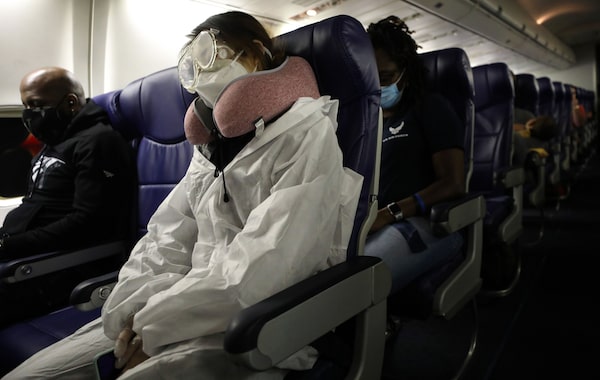
A passenger wears personal protective equipment while aboard a Southwest Airlines flight from Los Angeles to Houston on June 7, 2020.Mario Tama/Getty Images
Robert Greenhill is the executive chairman of Global Canada. Previously he was managing director of the World Economic Forum and an aerospace executive.
Air Canada, WestJet and American Airlines announced recently they would no longer keep middle seats empty to enable physical distancing on their aircraft. Their decision is supported by the International Aviation Transport Association (IATA), which argues that screening passengers for symptoms, requiring face masks and using HEPA air filters should be sufficient.
This view is not unanimous, even within the airline industry. Southwest Airlines, Delta and JetBlue decided to keep seats empty to maintain physical distancing and “make more space for safer travel.”
Health experts have reacted with consternation. Dr. Robert Redfield, director of the U.S. Centers for Disease Control and Prevention, noted his “substantial disappointment.” Dr. Anthony Fauci, head of the U.S. National Institute of Allergy and Infectious Diseases, added, “Obviously, that is something that is of concern.” B.C. Health Minister Adrian Dix asked to see “how this decision was made at the federal level and what the evidence is.”
When can I go back to the gym? A guide to Canada’s reopening and COVID-19
Citizens, who have been told that physical distancing is critical in bars and restaurants, are understandably confused why it is not necessary when seated side-by-side in aircraft.
It is critically important to understand the safety case for eliminating physical distancing on airplanes. If it is not safe and airlines proceed, it could significantly increase the spread of COVID-19, including to regions of the country with lower rates of infection.
If it is safe to fill all seats but airlines are forced to maintaining physical distancing, it could cripple an industry reeling from the impact of COVID-19.
Perhaps most perversely, if it is safe but customers are not convinced, eliminating physical distancing may actually undermine airlines’ recovery as travellers delay all but the most essential trips.
Fortunately, although the safety case is challenging to resolve in theory, it is relatively straightforward to test in practice. People with the coronavirus may not remember all their activities over the previous two weeks, but everyone remembers if they took a plane. Similarly, while it can be difficult for a bar to track who got close to a COVID-19 case, airlines can instantly access the data on who was sitting where.
The federal government is responsible for airline safety. It should agree with all provinces that contact-tracers will report as a priority COVID-19 cases that involve recent aircraft travel. Airlines should provide the contact information for people within three rows of an infected person. All should be contacted. Those within one row should be asked to get a COVID-19 test.
The information should be gathered by Transport Canada (or an objective third party) for statistical analysis and to inform Canadians. The overseeing body should provide regular updates on what proportion of flights have confirmed cases, and what proportion of people seated close to cases end up with COVID-19 themselves. Canadians will receive an increasingly clear, fact-based understanding as to what the real danger of infection is when flying.
This process will also provide valuable information to airlines and governments. If it confirms that there is no risk, it will allow the industry to fill all seats with confidence. If the results indicate significant risk, they can identify key factors (e.g. length of flight, closeness to infected passenger) so regulators can make evidence-based policy adjustments and, where necessary, reintroduce restrictions.
Although such a co-ordinated national approach should be relatively simple to set up, it is not yet in place. There is a national register of flights that were exposed to confirmed COVID-19 cases, but no information as to what proportion of flights that represents, let alone whether any other passengers became infected.
The international evidence on this critical issue is sparse. The IATA decision to reject physical distancing was based on data from two flights, an airline survey and a broad review of contact tracing without a standard methodology.
The danger of COVID-19 infection by air travel is particularly important for Canada. As the second-largest country in the world, we depend upon a vibrant, safe passenger-airline industry. As the host country for both the IATA and the International Civil Aviation Organization, we have a special interest in actions that allow the airline industry to safely address the COVID-19 crisis.
Canada has received good marks internationally for our non-ideological, fact-based approach to the pandemic. When it comes to deciding whether eliminate physical distancing on flights, Canada has an opportunity to apply this fact-based approach in a way that is good for Canadians, and for the benefit of the world.
Sign up for the Coronavirus Update newsletter to read the day’s essential coronavirus news, features and explainers written by Globe reporters and editors.